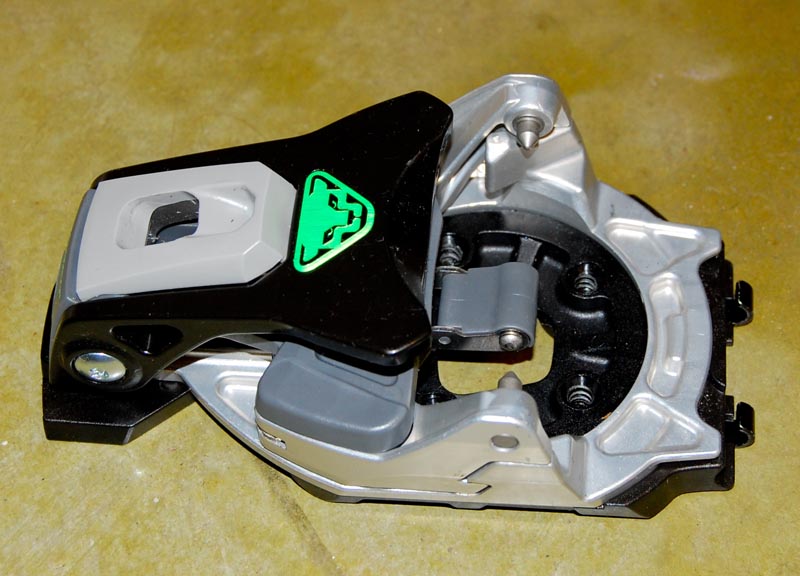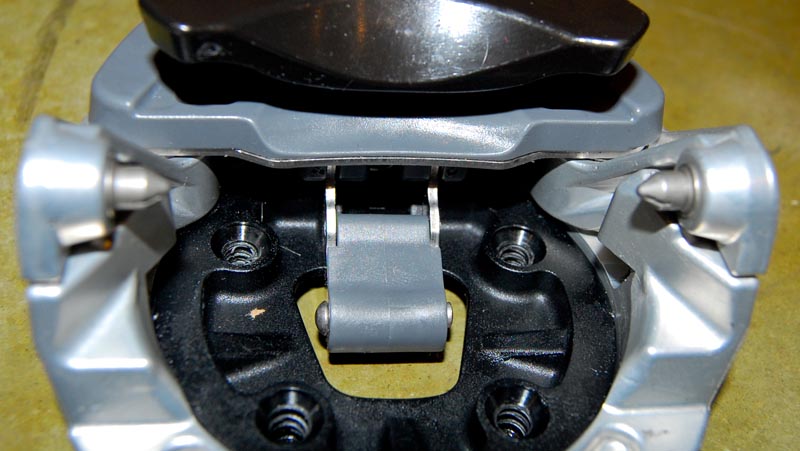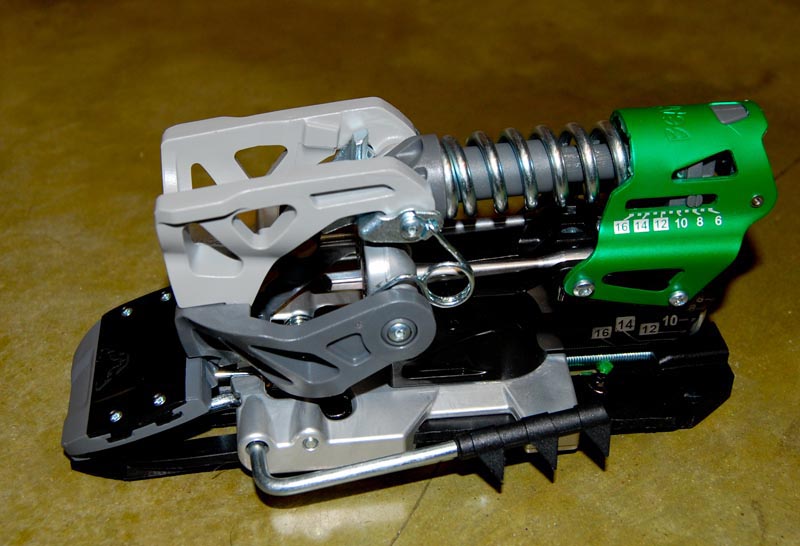tags:
the beast 16 |snow lab news |ski touring |ski |industry news |google news |featured |dynafit |company news |binding

The rumors have been flying  The full set-up: Dynafit Huascaran skis, Vulcan boots, and The Beast 16 binding.
The full set-up: Dynafit Huascaran skis, Vulcan boots, and The Beast 16 binding.  The Beast 16 toepiece. Note that the toe pincers pivot out and in to clamp the boot from the side.
The Beast 16 toepiece. Note that the toe pincers pivot out and in to clamp the boot from the side. A closer look at the toe piece. Note that the hole patterns will be different.
A closer look at the toe piece. Note that the hole patterns will be different. The center piece in this shot is what you step on with your boot to engage the toe.
The center piece in this shot is what you step on with your boot to engage the toe.
First, I'll present some general features of the binding, then follow up with details courtesy of Drew Saunders, director of operations at Dynafit.
General
Some of this general information is further outlined in Dynafit's press release, while some is courtesy of Dynafit.
Sales and accessories details
- Expected price is $1000. Release date is Oct 2013
- Brakes are provided in 105 mm, 120 mm, and 135 mm sizes
- Crampons are in the works
- Limited initial production run of 2,500 units
General gear nerd talk
- The binding mount pattern is unfortunately totally new. Basically, the binding pattern is designed to be wider underfoot. This makes sense given the intended target market that will be mounting this binding on wide skis (the minimum central width for the mount pattern is 80 mm).
- The rear heel fitting is different. Boot retrofit kits can be purchased for any boot where the heel fitting is affixed with screws (I believe this means BD boots are SOL, feel free to point out in the comments any other boots that can't be retrofitted)
- Frameless system – that means no frame is attached to the boot as it lifts in tour mode. This is worth mentioning, as it is a product differentiator from the competition.
- Beast 16 will have 6 mm ramp angle (compared with Vertical/Comfort/Radical ST/FT 17mm ramp, Speed Radical 15mm and Speed Superlight 3mm). At 23 mm (heel) and 17 mm (toe) above the ski, the Beast is designed to have a low binding height. The Beast 16 heel piece in ski mode, brakes deployed and binding forward on track.
The Beast 16 heel piece in ski mode, brakes deployed and binding forward on track.  The Beast with heel in tour mode. Such a chunk of metal should impress all the gnar bros.
The Beast with heel in tour mode. Such a chunk of metal should impress all the gnar bros. Close up of the boot-binding engagement point. The metal fangs should contact the boot bail (unknown if that improves retention).
Close up of the boot-binding engagement point. The metal fangs should contact the boot bail (unknown if that improves retention). Closeup of the teardrop shaped heel pins.
Closeup of the teardrop shaped heel pins. Closeup of the new heel fittings. Unknown how this will work as a retrofit. Sure hope no dremelling of fancy carbon/Grilamid is involved.
Closeup of the new heel fittings. Unknown how this will work as a retrofit. Sure hope no dremelling of fancy carbon/Grilamid is involved.
Detailed gear nerd discussion:
Thank you to Dynafit for patience and time answering all these questions.
DIN:
- The Beast is DIN 16. While all Dynafit binders are developed to ISO 11088 there is not an actual DIN standard for bindings past DIN 12, so that 16 measurement is from Dynafit.
- DIN Adjustment is only via the heel. The toe release is not adjustable. As with the previous generation tech bindings, vertical and lateral release is adjusted via different screws (see picture 11 and picture above).
Step-In System:
Dynafit touts in the marketing material that the Beast is step-in. It's not quite what one would expect, as one might commonly view as step-in (think Marker, Fritschi or Salomon mechanisms, to cite some examples). You will step into the Beast's toe piece the same way as you step into the previous generation’s toe piece. In other words, there will still be the marrying toe fitting to toe pins fiddle factor, especially in deep snow. Where there is some purported improvement is in the heel, where less entry force is required for the heel. (see picture 5 below). The boot will contact the grey metal jaw and as it does so, depressing the gray metal jaw causes the entire heel unit to slide back on a binding track away from the boot. Once you clear the gray metal jaw, the heel unit slides back into place.
Toe:
The toe is on a spring mechanism, with a return to centre and rotates/pivots approx 10 -15 deg (see picture 2). While this mechanism lends to elasticity (in the sense of theoretically having some small bump absorption and return-to-center character), there is no adjustment mechanism for the toe.
The toe pin attachment point is angled from the side in contrast to the previous generation Dynafits, where the toe pincers come at the boot tech fittings from the bottom and side. As you step into the center of the toe piece, the toe fittings are on two levers that swing in and engage the boot pins from the side. Theoretically, that side-loaded attachment point, coupled with the fact that the toe can rotate, should add to binding elasticity characteristics.
Heel:
There is forward pressure in the heel. I couldn't see if there was an adjustment mechanism to dial in forward pressure (perhaps that's inherent to the mechanism to adjust for boot sole length?) This should aid elasticity.
Heel and toe attachment points are the same as in previous generation bindings. The heel pins are spring loaded and are guided into the heel insert track, then the spring load forces them back in to the center of the heel insert track (see picture 9). The heel slots are quite a bit wider than the previous generation of Dynafit bindings. Perhaps that, too, aids elasticity in that there is more latitude for the heel to move from side to side — but that's speculation on my part.
One big issue with the previous generation of bindings was over reliance on heel pin strength, in that the entire boot rested on the binding with only incidental contact on the brake pad. With the Beast, the boot now rests on both the pins, plus the brake pad (see picture 8).
Another change is the ovalization of the heel pins (see pictures 3 and 4). Previous generations of Dynafits had round pins, which by their nature only contacted the heel insert at one point. The ovalized pins contact the heel inserts with more surface areas. Better mechanical contact theoretically should result in more solid contact, which should then improve strength and retention, all things being equal.
At this point in time, there are only a few athletes on the binding in BC including Hoji, Trevor Hunt and a few of Dynafits reps and marketing people. Skiing and performance impressions accordingly will have to wait.
Shop for you next pair of Dynafit bindings at Backcountry.com


